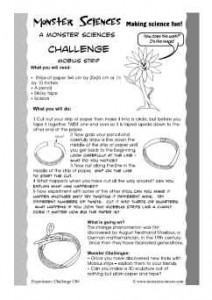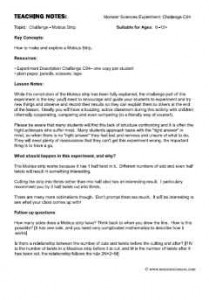Learn how to make a Mobius Strip, then use your creativity to explore all the features of them. Try different twists and different cuts and see what happens. Do your observations make it easier to understand how it works?
 |
 |
What you will need:
• Strips of paper 3-4 cm by 20-25 cm or 1½ by 10 inches
• A pencil • Sticky tape • Scissors
What you will do:
- Cut out your strip of paper then make it into a circle, but before you tape it together TWIST one end over so it is taped upside down to the other end of the paper.
- Now grab your pencil and carefully draw a line down the middle of the strip of paper until you get back to the beginning. Look carefully at the line – What do you notice?
- Now cut along the line in the middle of the strip of paper. Snip on the line to start the cut.
- What happens when you have cut all the way around? Can you Explain what has happened?
- Now experiment with some of the other strips. Can you make it happen another way? Try twisting it different ways. Try different numbers of twists. Cut it into thirds or quarters. What happens if you join two moebius strips like a chain? Does it matter how big the paper is? What is going on? This strange phenomenon was first discovered by August Ferdinand Moebius, a German mathematician, in the 19th century. Since then they have fascinated generations.
Monster Challenges:
• Once you have discovered new tricks with Mobius strips – explain them to your friends.
• Can you make a 3D sculpture out of nothing but plain paper and tape?
TEACHING NOTES: Monster Sciences Experiment: Challenge C04
Topic:
Challenge – Mobius Strip
Key Concepts:
How to make and explore a Mobius Strip.
Resources:
• Experiment Description Challenge C04– one copy per student
• plain paper, pencils, scissors, tape
Lesson Notes:
While the constrution of the Mobius strip has been fully explained, the challenge part of this experiment is the key: you’ll need to encourage and guide your students to experiment and try new things and observe and record their results so they can explain them to others at the end of the lesson. Ideally you will have a buzzing, active classroom during this activity with children informally cooperating, comparing and even competing (in a friendly way of course!).
Please be aware that many students will find this lack of structure confronting and it is often the high achievers who suffer most. Many students approach tasks with the “right answer” in mind, so when there is no “right answer” they feel lost and nervous and unsure of what to do. They will need plenty of reassurance that they can’t get this experiment wrong, the important thing is to have a go.
What should happen in this experiment, and why?
The Mobius strip works because it has 1 half twist in it. Different numbers of odd and even half twists will result in something interesting.
Cutting the strip into thirds rather than into half also has an interesting result. I particulary recomment you try 3 half twists cut into thirds.
There are many more cobinations though. Don’t prompt them too much. It will be interesting to see what your class comes up with!
Follow up questions:
How many sides does a Mobius strip have? Think back to when you drew the line. How is this possible? [It has one side, and you need very complicated mathematics to describe how it works]
Is there a relationship between the number of cuts and twists before the cutting and after? [If N is the number of twists in a Moebius strip before it is cut, and M is the number of twists after it has been cut, the relationship follows the rule 2N+2=M]
© www.monstersciences.com



